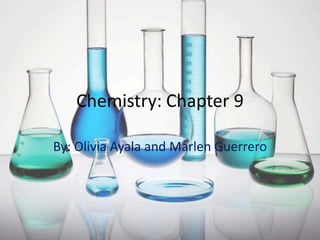
Chemistry
- 1. Chemistry: Chapter 9 By: Olivia Ayala and Marlen Guerrero
- 2. Equations: • Equations: are recipes that show a person how much reactant they have to mix and what amount of product they will end up with. • The study of quantities in chemical reactions is called stoichiometry. • EX: Cookies~! – 3eggs + 1batter + 2cu. Milk 12cookies – 9eggs + 3batter + 4cu. Milk 24 cookies – 9eggs + 3batter + 6cu.Milk 36 cookies
- 3. Interpreting Chemical Equations • N2 (g) + 3H (g) 2NH3 (g) – What type of information can we retrieve from this? • Particles: that one molecule of Nitrogen reacts with 3 molecules of Hydrogen to form 2 Ammonia in a 1:3:2 ratio. This tells you how many moles of each reactant are needed to make the product. • Moles: Avagadro’s number (6.02x10^23) is equal to 1 mol of representative particles of substance. The equation tells you how many moles of each reaction you need to make X mols of the product. • Mass: “Mass cannot be created or destroyed” is the law of conservation of mass. This holds true with mols. If you have 1 mol of a 25g element and 2 mols of a 30g element and they react to form 1 mol of a compound that is 55g, then it is following the conservation of mass. • Volume: Assuming STP you can tell from the equation above that 22.4L of Nitrogen reacts with 67.2L of Hydrogen to form 44.8L of Ammonia.
- 4. Interpreting Equations: • 2H2 (g) + O2 (g) 2H2O (g) – How many Liters of gas are present as reactants? How many Liters of gas are present as products? – How many mols of each element are on the reactant side? How many mols on the product side? – What are the masses of the reactants and the product?
- 5. Mole-Mole Calculations • N2 + 3H2 2NH3 – Here you know that one mol of Nitrogen reacts with three mols of Hydrogen to make two mols of Ammonia. The coefficients of this balanced equation can be used to write a mol ratio: • (1mol N2)/(3mol H2) (2mol NH3)/(1mol N2) • (3mol H2/ 2mol NH3)
- 6. Mole Calculations Con’t • No one can measure substances directly in mols. • The mass is usually measured in grams. By finding the mass of the product a person can find the mass of any other reactant or product in the equation.
- 7. PRACTICE PROBLEM TIME! (Yay?) • 4Al + 3O2 2AL2O3 – How many mols of Oxygen are required to react with 14.8 mol of Al? – How many mols of Al2O3 are formed when 0.78 mol O2 reacts with Aluminum?
- 8. More Practice Problems! (…yay?) • CaC2 + 2H2O C2H2 + Ca(OH)2 – How many mols of CaC2 are needed to react completely with 49.0 g of H2O?
- 9. More Mass-Mass Calculations (Oi vey!) • Remember: (For example) Even though you have 5.0 g of Hydrogen and end up with 31g of NH3, there IS a logical explanation for it! The Law of conservation of mass! If you calculate how much Nitrogen is needed to produce the NH3 you will find your missing mass.
- 10. Conversions~ • Mass G Moles of G = MassG X ((1mol G)/(molar massG)) = mol G • Mols G Mols W= – MolG X ((Molar mass W)/(1mol W)) = mass W Mols W grams W = -- mol W X ((molar mass W)/(1mol W)) = Mass W
- 11. More Equations?!?! • 9) • This equation shows the formation of Aluminum oxide. • 4Al (s) + 3O2 (g) --> 2Al2O3 (s) • A) Write the six mole ratios that can be derived from this equation. • B)How many moles of Aluminum are needed to form 3.7 Al2O3 • (I'm going to refer back to this question in the limit reagent and the percent yield OK) • 10) Using the equation above • A) How many moles of Oxygen are required to react completely with 14.8 mol Al? • B) How many moles of Al2O3 are formed when 0.78 mol O2 reacts with Aluminum. • 12) • CaC2 (s) + 2H2O (l) --> C2H2 (g) + Ca(OH)2 (aq) • Determine how many moles of CaC2 are needed to react completely with 49.0 g H2O
- 12. A Limiting Reagent? Oh no, not this again. • Don't worry its not so hard. Just remember that the limiting reagent is used up in the reaction and whenever quantities of two or more reactants are given in a stoichiometry problem, the limiting reagent MUST be identified. WHY? Because the amount of the limiting reagent determines the amount of product formed in a chemical reaction. • Let's use an example: • Suppose you are making cookies and you have more than enough eggs, flour, and sugar (excess reagents). However you only have a limited amount of milk. The amount of cookies that you can make is limited by the milk, thus the milk is the limiting reagent.
- 13. Let's put it in chemistry terms: • A balanced equations is a recipe that can be interpreted on a varied scale • Using the equation: 4Al (s) + 3O2 (g) --> 2Al2O3 • We can concluded other units can be represented. • 4 molecules of Al + 3 moles of O2 --> 2 molecules of Al2O3 • 4 moles of Al + 3 moles of O2 --> 2 moles of Al2O3
- 14. Calculating the Percent Yield • The Theoretical yield is the maximum amount of product that could be formed from the given amounts of reactants. In contrast, the amount actually produced in a laboratory is called the actual yield. The actual yield is an experimental value and normally is less than 100%. • Percent yield= (Actual Yield / Theoretical Yield) * 100%
- 15. … YAY YOU’RE DONE! NOW REVIEW! It’s all fair game from here folks!